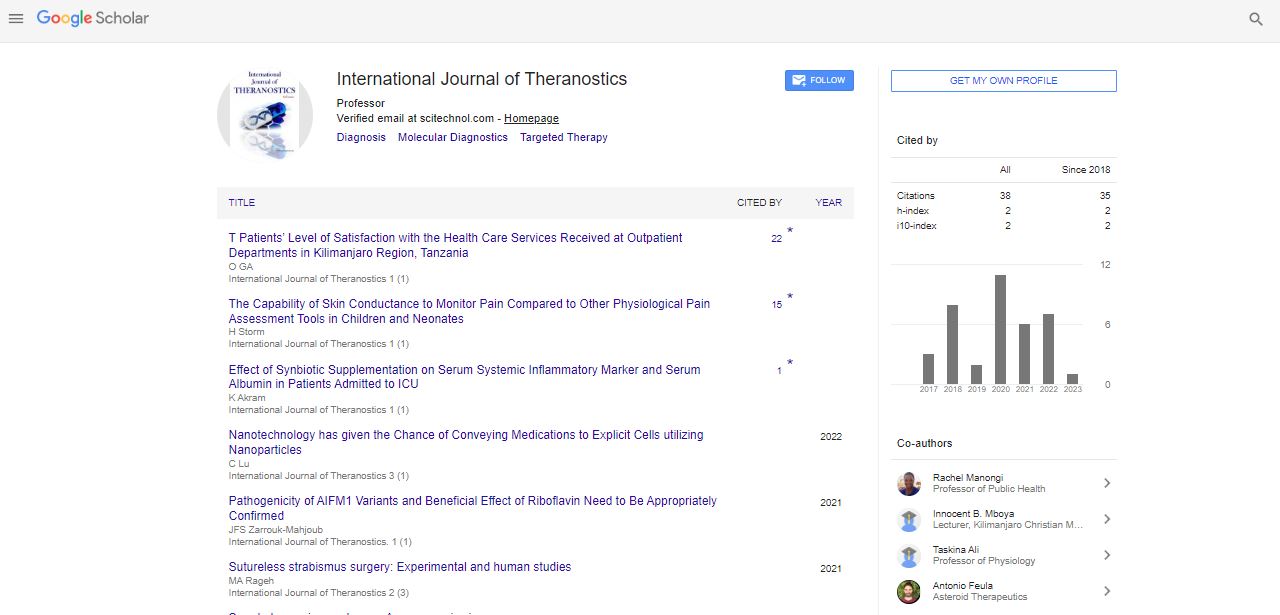Opinion Article, Int J Theranostic Vol: 12 Issue: 2
Revolutionizing Personalized Medicine: The Theranostics Era
Frick Han*
1Department of Nanotheranostics, National University of Singapore, Queenstown, Singapore
*Corresponding Author: Frick Han,
Department of Nanotheranostics, National
University of Singapore, Queenstown, Singapore
E-mail:Frickhan01@hotmail.
com
Received date: 29 May, 2023, Manuscript No. IJT-23-106889;
Editor assigned date: 31 May, 2023, PreQC No. IJT-23-106889 (PQ);
Reviewed date: 14 June, 2023, QCNo IJT-23-106889;
Revised date: 21 June, 2023, Manuscript No. IJT-23-106889 (R);
Published date: 30 June, 2023, DOI: 10.4172/IJT.1000125
Citation: Han F (2023) Revolutionizing Personalized Medicine: The Theranostics Era. Int J Theranostic 12:2.
Description
Theranostics, a novel approach in medicine, has gained significant attention in recent years due to its potential to revolutionize personalized healthcare. Combining diagnostic and therapeutic capabilities, theranostics seeks to target specific diseases with tailored treatments, enhancing efficacy and minimizing side effects. This study provides an overview of theranostics, its applications, challenges, and future prospects, highlighting its role in advancing personalized medicine.
Theranostics is an emerging field at the intersection of diagnostics and therapeutics. Its primary objective is to enhance precision medicine by offering targeted therapies based on individual patient characteristics. This study discusses the multifaceted aspects of theranostics and its impact on the healthcare landscape.
The theranostic approach
The theranostic approach involves integrating diagnostic tools, such as imaging and biomarker analysis, with therapeutic agents to achieve personalized treatment. By identifying specific biomarkers or genetic profiles associated with a disease, clinicians can tailor treatment plans, resulting in better outcomes.
Applications of theranostics
Oncology: Theranostics has shown tremendous significance in oncology. Utilizing molecular imaging, clinicians can precisely detect tumors and monitor their response to treatment. Therapeutic agents, such as targeted nanoparticles and radiolabeled compounds, allow for site-specific delivery of therapies, leading to increased efficacy and reduced off-target effects.
Neurological disorders: In neurology, theranostics aids in early disease detection and monitoring progression. Advanced imaging techniques, like Positron Emission Tomography (PET) and Magnetic Resonance Imaging (MRI), provide valuable insights into neurodegenerative processes. Targeted therapies, including gene therapies and nanoparticles, hold potential in treating neurological disorders at their root cause.
Infectious diseases: The rise of antimicrobial resistance has spurred interest in theranostics for infectious diseases. Diagnostic tools enable rapid identification of pathogens and their drug susceptibility profiles. Consequently, clinicians can prescribe personalized antimicrobial regimens, improving treatment success rates.
Challenges in theranostics
Biomarker identification: The identification of reliable biomarkers is an important for successful theranostics. Some diseases lack specific biomarkers, hindering accurate diagnoses and targeted treatments. Research efforts are necessary to discover new biomarkers and validate existing ones.
Regulatory hurdles: Regulatory agencies face challenges in approving theranostic agents due to their complex nature. Harmonization of regulations and guidelines is essential to facilitate the translation of theranostics from research to clinical practice.
Cost and accessibility: Theranostic technologies can be expensive, limiting accessibility for patients, especially in resource-constrained settings. Innovations in manufacturing and distribution are needed to make theranostics more affordable and widely available.
Future perspectives: The future of theranostics looks efficacy, with ongoing research and technological advancements. Collaborative efforts between researchers, clinicians, and industry stakeholders will drive innovation and accelerate its adoption. As the field matures, theranostics has the potential to become a standard of care in various medical specialties.
Conclusion
Theranostics represents a groundbreaking approach in personalized medicine, offering the potential for targeted and precise treatments. Its integration of diagnostics and therapeutics holds significance for improving patient outcomes and reducing the burden of disease. Addressing challenges and fostering research collaborations will pave the way for a brighter future in theranostics.
 Spanish
Spanish  Chinese
Chinese  Russian
Russian  German
German  French
French  Japanese
Japanese  Portuguese
Portuguese  Hindi
Hindi 